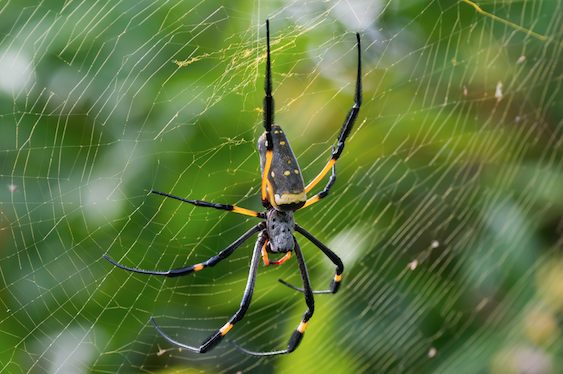Move over Stradivarius! Spider-varius instrument is made from silk spun by the Australian Golden Orb Spider.
Vibrations in webs alert spiders to captured prey, but now a postgraduate student at the Dyson School of Design and Engineering at Imperial College in the UK has harnessed the acoustic properties of spiders’ silk to create a new kind of violin. Luca Alessandrini built his prototype instrument using a composite material made from spider silk fibres mixed with a binding agent. The silk of the Australian Golden Orb spider was chosen as it is one of the strongest in the world. In addition to the silk fibres, Alessandrini’s violin features three strands of golden silk embedded in the instrument’s top side.
“The amazing properties of spider’s silk mean that it serves many purposes,” Alessandrini said “It’s a home, a net for catching food and a means of communicating – via vibrations – when prey is ready to be pounced on and devoured. Spiders’ silk has only previously been exploited as string in bows for instruments, but I’ve discovered that the amazing resonating property of spiders’ silk has massive potential uses in instruments themselves.”
 Luca Alessandrini with his prototype spider violin
Luca Alessandrini with his prototype spider violin
Differences in the way the silk fibres are mixed with the binding agent subtly affect the acoustics of the instrument, allowing Alessandrini to potentially engineer violins with a variety of predetermined tones and sonorities. Alessandrini’s research into the acoustic properties of composite materials could also have ramifications for the manufacturing of audio technology such as speakers, amplifiers and headphones.
This isn’t the first time spiders’ silk has been used in instrument making. Japanese researcher Shigeyoshi Osaki, a professor at Nara Medical University in Honshu used the silk from hundreds of Nephila Maculates (another species of Golden Orb spiders) to craft a set of violin strings in 2012. This is the first time, however, that silk fibres have been used to construct the body of a violin.
 The Golden Orb Spider
The Golden Orb Spider
Alessandrini worked with Italian violin making association, Associazione Nazionale Liutai Artistici Italiani to create his prototype. The association’s founder, Gualtiero Nicolini, put Alessandrini in touch with 20 violin makers and luthiers in the city of Cremona – birthplace of Antonio Stradivari. Alessandrini has now patented his technology and plans to use more sophisticated technologies and modelling processes to manufacture instruments. He is looking for partners in his start-up business and predicts his violins will be on the market by 2017.
He showed his prototype instrument to British violinist Peter Sheppard Skaerved. “I have been working with great violinists my entire career,” said Skaerved, “and I have been in discussions with makers and players about the limited capabilities of other manmade materials such as carbon fibre. These have not seemed to offer the organic subtleties of wood. My encounter with the prototype instrument developed by Luca has filled me with excitement. This approach offers a tremendous opportunity to move forward instrument making, using new materials in a way I have long hoped.”











Comments
Log in to join the conversation.